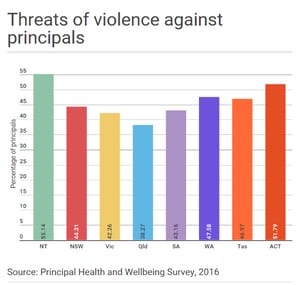This is the second article in a two-part series regarding the concerns of principal burnout and safety. In this series, Craig D'cruz, National Education Consultant at CompliSpace, writes about the recent statistics and real life examples of principal safety concerns.
In our first article of this two-part series regarding information gleaned through the Australian Principal Occupational Health, Safety and Wellbeing Survey (2016), we noted that many principals indicated that the main causes for their levels of stress and burnout were the sheer quantity of administrative work and insufficient time to focus on teaching and learning. However, another factor that has become more apparent in recent years across all states and territories has been escalating levels of violence or violent threats brought against principals and school leaders.
This increase in violence against principals has recently been reported in News.com.au, the Sydney Morning Herald (see the table below), the Courier and The West Australian.
The escalating risk of violence has resulted in the WA Primary Principal’s Association putting a case to the Department of Education that government school primary principals must have panic buttons, linked to police stations, installed in every WA public school to combat violence from parents. In WA, nearly one in two government school primary principals have experienced threats of violence and 40 per cent were victims of violent attacks. School Governance raised this issue in a 2015 article.

The Wellbeing Survey showed an increase in violence against principals from 27 per cent in 2011 to 34 per cent in 2016 (one in three principals). In addition, 44 per cent of the principals surveyed acknowledged that they had been threatened with violence at school. In the NT and the ACT the threats of violence were reported by more than 50 per cent of all respondents.
Rob Nairn, Executive Director of the Australian Secondary Principals Association, and a member of the consultative committee for the Wellbeing Survey, said: “it’s alarming the issues are unchanged since 2011, when the first survey was done, and that violence is increasing. As a school leader I’ve been verbally abused, my staff have been verbally abused, I’ve had incidents where I have been threatened,” he said. “There appears to be a growing lack of respect for principals, teachers...and this must be addressed.” Mr. Nairn said the rise of violence is systematic of what is happening in society.
In 2015, Stephen Breen, immediate past president of the Western Australian Primary Principals’ Association (WAPPA) commented that “Managing administrative and educational outcomes as well as abusive parents can be too daunting for educators to volunteer for the position. The consequence of the disturbing trend of abusive parents is significant stress on school leaders as they attempt to navigate these conflicts”.
However, in a 2016 School Governance article “Why be a School Principal?” we noted: “There are still teachers who aspire to be principals. They look beyond the day to day, the politics and the perceived lack of time. They look at how they can develop, lead and drive the culture within the school. If you speak with principals about their jobs, many will tell you that it is the ‘best job in the world’. They feel that they can make a difference in the lives of so many young people. Their actions drive the culture within the school and hence can affect every member of their school community.”
Recommendation 7 of the Wellbeing Survey (2016) (at page 14) is very clear:-
7. Stop the offensive behaviour. This is beyond debate. It simply must stop. The real issue is how to achieve this outcome. The steadily increasing levels of offensive behaviour across the country in schools of all types should give us pause. But this is not just occurring in schools, with increases noted in all frontline professions and domestic violence rates that we should be nationally ashamed about. Australia needs to have an adult conversation about the root causes of this and set about addressing them at every level of society.
If we want to continue to encourage top quality teachers to aspire to become school leaders and lead our school culture, then we need to look closely at our school succession plans and at how we support our current school leaders and prospective school leaders. Do we “provide opportunities for our leaders to engage in regular support networks, mentoring and provision of time to access support, as well as targeted professional support? According to comments by Beausaert, “social support predicts decreased stress and in turn burnout in school principals”.
Above all, we need to ensure that we have supportive boards with well thought out policies and procedures in place to mitigate these very high level risks regarding the physical and emotional threats to the leadership of our schools. What price are we prepared to pay for the loss of a quality school leader?




